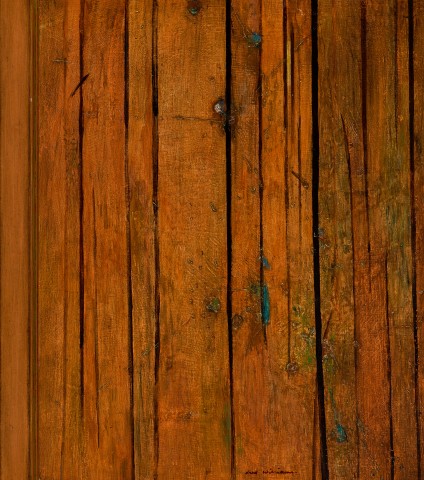ECHUCA LANDSCAPE, c.1960 – 62
FRED WILLIAMS
oil on composition board
89.0 x 72.0 cm
signed lower centre: Fred Williams.
Rudy Komon Gallery, Sydney
Private collection
Geoff K. Gray, Sydney, 17 November 1976, lot 99 (as ‘Echuca’)
Private collection
Geoff K. Gray, Sydney, 17 November 1986, lot 99 (as ‘Echuca’)
Private collection
Christie’s, Melbourne, 20 August 1996, lot 47
Private collection
Christie’s, Melbourne, 23 November 1999, lot 132
Joseph Brown Gallery, Melbourne
The Cbus Collection of Australian Art, Melbourne, acquired from the above on 25 November 1999
Fred Williams and John Nixon - Reducing Landscapes, Latrobe Regional Gallery, Victoria, 21 March – 28 June 2015 and touring
on long term loan to Wollongong City Gallery, New South Wales
Nainby, B., Stanhope, Z., and Furlonger, K., The Cbus Collection of Australian Art, in association with Latrobe Regional Gallery, Melbourne, 2009, pp. 15, 99 (illus.), 237
Echuca Landscape, 1962, oil and tempera on composition board, 138.8 x 122.2 cm, in the collection of the National Gallery of Victoria, Melbourne
Upon returning to Australia in 1957 after studying abroad at the Chelsea School of Art, London and absorbing firsthand the influence of European masters such as Rembrandt, Goya and Cézanne, Fred Williams was confronted anew by the light, scale and harsh beauty of the unique Australian environment. Subsequently dedicating his career to exploring the local landscape, in 1959 he thus embarked upon an excursion with fellow artist, Arthur Boyd, to sketch at Echuca and Sherbrooke Forest which would become the inspiration for his ground-breaking Forest series (1961 – 62). A superb example of the series, Echuca Landscape, c.1960 – 62 is characteristic of his work at this time with Williams skilfully evoking the bush through minimal gestures; the forest is reduced to an impressionistic red and gold ground, while thin vertical lines represent a stand of saplings.
As Patrick McCaughey elaborates in his comprehensive tome on the artist, '…The story of the Forest series is as much the story of the expansion of Williams expressive powers in landscape painting as of growing, formal mastery. Williams explores two opposing interpretations of the bush; airless, sunless and oppressive on the one hand, and on the other, luminous filled with light and heat… Most of the Forest paintings are worked in warm, earth colours – brilliant ochres, rich browns and siennas, and yellows that almost turn golden at times. After the brooding mysterious image of the forest, these paintings frequently have the shimmer of light and heat. They are vibrant both in colour and touch and celebrate the physical strengths and texture of the bush. From an image of the dark, enclosing forest, Williams opens up the paintings and gives an image of the bush as glowing and light-filled. Williams' confidence visibly returns as the series proceeds…
During the series Williams would frequently explore seeming contradictions. One group takes the abstract geometry of the sapling trunks and makes a whole work from it. Such paintings show Williams aiming for the bones of the landscape where drawing becomes almost schematic in its austerity and abstractness. Yet even those are warmed by his palette which draws so closely on nature… At the other extreme of the Forest series is a group of works which takes a single image of a tree trunk. Compared with the lightness and delicacy of the geometric paintings, these dense and monumental works emphasise the physical qualities of image and surface alike. Williams worked up the textures of these paintings so that they recall in touch the roughness of bark and wood. He made the whole painting from touch, arguing an almost literal equivalence between the weight and density of paint and the weight and density of the motif. These monolithic images of trunks project a notion of permanence and obduracy, massive forms whose hugeness could only be grasped in fragments. They were products of Williams' intense scrutiny of his motif as he moved his art into close-up, matching his experience of monumental form and effect in nature with an art of similar resonance and substance...’1
1. McCaughey, P., Fred Williams, Bay Books, Sydney, 1980, pp.143 – 45
